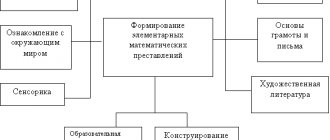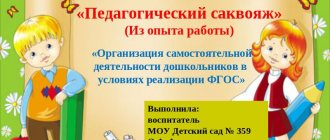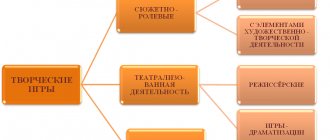MAGAZINE Preschooler.RF
“Travel games as an organization of joint activities between an adult and a child”In accordance with the Federal State Educational Standard in working with children of senior preschool age, one of the main principles is the principle of forming the child’s cognitive interests and cognitive actions, as well as the principle of supporting children’s initiative in various types of activities.
The priority of the Federal State Educational Standard for Preschool Education is gaming technologies, since gaming is the leading activity of preschool children.
The construction of an integrative pedagogical process involves the primary use of visual and practical methods and ways of organizing activities. Joint creative projects, holidays, observations, excursions, elementary experiments, travel games, game problem situations, role-playing games, etc., but I would like to dwell in more detail on travel games as an effective means of developing cognitive activity and initiative children in various types of activities in children of senior preschool age.
In older preschool age, intellectual interests are created on the basis of play interests. The ability to think independently, use acquired knowledge in mental operations is formed: find characteristic features, compare, group, classify objects, navigate in space, draw correct conclusions. All this will further contribute to successful learning at school. In this regard, the problem of developing the cognitive activity of preschool children, today, is becoming increasingly relevant. The goal of our work is to increase the level of cognitive activity of preschoolers through travel games.
Tasks:
- Development and activation of cognitive processes in children of senior preschool age;
- Formation of the ability to solve problem-search, game problems;
- Creating conditions for the development of independent cognitive activity. The practical significance and novelty of our work lies in the fact that the use of travel games in modern preschool educational institutions allows the teacher to effectively solve a number of issues related to the development of children’s cognitive activity and initiative in various types of activities, through the integration of educational areas.
The travel game is a sequential visit to various points on a previously prepared route. The children are given a task that has a playful nature (they go to Tsar Berendey, to the sweet tree). It is necessary to organize stops along the route where children will be offered various games and tasks.
Travel games are similar to a fairy tale, its development and miracles. They reflect real facts and events, but the ordinary is revealed through the unusual, the simple through the mysterious, the difficult through the interesting. All this happens in play, in play actions, it becomes close to the child and makes him happy.
A travel game is a game of action, thoughts, feelings of a child, a form of satisfying his needs for knowledge. The name of the game and the formulation of the game task should contain “calling words” that arouse children’s interest and active play activity. In a travel game, many ways of revealing cognitive content are used in combination with gaming activities: setting tasks, clarifying ways to solve them, sometimes developing travel routes, solving problems step by step, the joy of solving them, meaningful rest. The game sometimes includes songs, riddles, gifts and much more.
The purpose of the travel game is to enhance the impression, to make the educational content a little more fabulously unusual, to draw children’s attention to what is nearby, but is not noticed by them.
Thanks to travel games, children develop mental processes such as attention, memory, imagination, and perception more effectively. Children are given tasks such as overcoming difficulties and achieving success, which contributes to the development of logical thinking. Travel games arouse interest and active participation in the development of the game’s plot; children strive to master the rules of the game and get a result: solve a problem, find out something, learn something.
For example, in the game “Trip to the Zoo,” children gain knowledge about geometric shapes, repeat counting, and solve riddles.
In the game “Travel to Hometown,” children dance and listen to music; this includes tasks for attention, the ability to work in groups, and the ability to negotiate.
Thus, we can conclude that travel games for developing children’s initiative in various types of activities, for the formation of cognitive interests and cognitive actions of older preschoolers, are very effective.
| Next > |
“Joint activity of adults and children” is the main model for organizing the educational process of preschool children; the activity of two or more participants in the educational process (adults and students) to solve educational problems in the same space and at the same time.
It is distinguished by the presence of a partner (equal) position of an adult and a partner form of organization (the possibility of free placement, movement and communication of children in the process of educational activities). It assumes individual, subgroup and frontal forms of organizing work with students.
The federal state educational standard for preschool education is aimed at combining teaching and upbringing into a holistic educational process based on spiritual, moral and sociocultural values and socially accepted rules and norms of behavior in the interests of the individual, family, and society; ensuring variability and diversity of the content of educational programs and organizational forms of the level of preschool education, the possibility of creating educational programs of various directions, taking into account the educational needs and abilities of children.
At present, the tendency of the movement of modern civilization to reflect universal human values, national culture, and spirituality has clearly emerged.
Modern children live in an era of progress, the latest innovative technologies, and computerization. It has become commonplace that children already at preschool age have the skills to handle multifunctional devices: a computer, an iPhone, an iPad... There is no doubt that this develops the child’s cognitive interest, his thinking, attention, memory, and reaction speed. But, in my opinion, universal human values, national culture and spirituality are considered an integral part of modern education.
The general education program provides for the solution of program educational tasks in the joint activities of adults and children and the independent activities of children, not only within the framework of direct educational activities, but also during routine moments in accordance with the specifics of preschool education.
One of the most important factors influencing the professionalism of a teacher and the organization of joint partnership activities between an adult and a child is self-education. The topic on which we have been working for four years, “Cognitive development of preschool children through familiarization with the culture of the peoples of the Southern Urals,” is relevant and significant.
At the present stage, the state educational standard of requirements for preschool education includes the presence of a regional component for the development and education of preschool children. The program for the education and development of preschool children based on the ideas of folk pedagogy “Our Home is the Southern Urals” by Elena Semyonovna Babunova was taken as the basis for the work on self-education.
The presence of a methodological complex on the regional component of the development of preschool education allowed us to familiarize ourselves, study and create a long-term work plan in this direction.
Currently, in world practice there is an aggravation of interethnic conflicts, which lead not only to human losses, but also to the destruction of both national and world culture.
Therefore, the main goal of our work is: to promote the education and development of children on the ideas of folk pedagogy through the organization of joint partnership activities between an adult and a child, to help children enter the world of folk culture and make it their property.
Turning to folk traditional culture as a means of instilling in children national tolerance, interest in the history and culture of different peoples, awareness of their national “I,” the formation of emotional responsiveness and friendliness is very relevant and generally significant today.
It so often happens that in a preschool institution there are pupils who are representatives of the indigenous peoples of the Southern Urals: Tatars, Bashkirs, Russians. Therefore, work in this direction was predetermined by us.
At the first stage of our work, we organized a “Round Table” with the parents of the senior group, which highlighted the relevance of educating the younger generation on the traditions of the folk ethnoculture of the Southern Urals.
They asked parents to provide all possible assistance in creating a mini-museum of the ethnoculture of the Tatars and Bashkirs in a group, which could include household items, dishes, clothing, and jewelry. Parents became interested in our idea, readily responded and supported it. Gradually, the group's mini-museum was replenished. The children were happy to bring exhibits, look at them, and communicate.
We organized meetings with interesting people who introduced children to traditions, customs, and holidays (Sabantuy, Kargatuy). These meetings in the educational aspect were not in vain, since folk traditions contain rich educational potential: preschoolers become familiar with the culture of another people, adapt to the values and characteristics of the region. Folk cultural and historical traditions combine spiritual, historical, cultural, and family education of children.
We created conditions for the manifestation of children's gaming culture through the formation of interest in Bashkir and Tatar folk games. We enriched the intellectual and information sphere of children with knowledge of the rules of many folk games, since folk games are one of the means of folk pedagogy. The new living conditions of modern people do not allow us to raise children the way our distant ancestors raised them. But it is necessary to know these features of upbringing and it is necessary to borrow from the richest heritage everything that is interesting and useful.
We continued to introduce children to the folk art of the Bashkirs and Tatars. We got acquainted with the national dwelling of the Bashkirs (yurt), compositional artistic features of the design of the home; kitchen utensils (cauldron, bowl); items of clothing (skullcap, ichigami), jewelry. Introduction to folk art was carried out through various forms of work with children. One of the most effective forms of working with children was a circle called “Ural Patterns.”
A visit to the Chelyabinsk Museum of Local Lore helped expand children’s understanding of the ethnoculture of the peoples of the Southern Urals.
The result of activities in this area is: introducing children to the folk culture of the Tatars and Bashkirs, to the development of an emotionally effective relationship, information and intellectual competence, and ethnocultural socialization.
The demographic features of the Ural region make it possible to expand the scope of the content of folk art, since different peoples live on the territory of the region: Russians, Tatars, Bashkirs, Ukrainians, Nagaibaks and others. The largest ethnic groups are representatives of the Russian, Bashkir, and Tatar nationalities.
Since at the first stage work was carried out to familiarize children with the cultural traditions of the Tatars and Bashkirs, at the second stage there was a need to familiarize children with the cultural and historical traditions of the Russian people.
In this area, a series of conversations and summaries of direct educational activities has been developed to expand and clarify children’s knowledge about the cultural and historical traditions of the peoples of the Southern Urals.
At an early and younger age, work in this direction was carried out through familiarization with different genres of folklore (nursery rhymes, ditties, jokes, songs, pestushki, chants, lullabies). In older preschool age, in addition to the use of all genres of folklore (proverbs, sayings, fables, teasers, riddles, legends and legends of the native land), familiarization with the traditions, customs, housing, utensils, and decorative and applied arts of the Russian people was carried out.
Materials were collected to familiarize children with the folklore of the peoples of the Southern Urals: fairy tales, proverbs, sayings, riddles, chants, sayings, jokes.
To familiarize children with the traditional housing and life of Russian peasants, it became necessary to create a mini-museum “Russian Izba”. Not only parents helped us in this, but also all the employees of the preschool institution, each of whom contributed.
Authentic works of folk art are important cultural and historical evidence of the rules of careful attitude of our ancestors to objects of folk life. Therefore, in our museum there appeared: a “red corner” (with icons), a Russian stove with a damper and a grip, kitchen utensils (lids, cast iron, clay and wooden dishes, a samovar), wicker baskets, bast shoes, chests, a rocker with buckets), carved boxes, figurines, knitted tablecloths, napkins, rugs, embroidered towels...
The development of the costume of each people occurs in close connection with the cultural experience of neighboring peoples. Traditional clothing reveals the deep roots of the history of interaction between the peoples inhabiting the Urals. While introducing children to the peculiarities of national Russian clothing, we did not focus the children’s attention on the differences in the clothing of Russians, Tatars and Bashkirs. The main attention was paid to beauty, unusual colors, individual details, and decorations. I would like to note that our preschool has preserved national costumes, which were lovingly restored by employees and parents; Tatar boots - ichigs, headdresses - skullcaps, dresses were sewn.
On visual activities and artistic work, the following was created: a visual and methodological guide “Folk Patterns”: (samples and sequence of decorating objects with folk patterns); educational games: lotto game “National Costumes”, “Make a National Costume from a Picture”, “Card Quiz”.
In the Urals, Russian people organized games, fun, and get-togethers on Sundays and holidays. They were a rest for a person, his amusement. Gatherings and evenings absorbed the originality and local characteristics of the region. We held Russian folk gatherings with children in Russian folk costumes, in the form of tea drinking over a samovar with traditional pastries, singing Russian folk songs, and handicrafts.
During Russian seasonal holidays: Christmastide, Maslenitsa, Easter, Trinity, Ivan Kupala, they sang ritual holiday songs, danced in round dances.
One of the traditions in the Urals was the joint participation of adults and children in various competitions, caroling, round dances, evening gatherings, singing Russian folk songs and ditties. The singing of songs always took place to the sound of Russian folk instruments, so we introduced the children to ancient musical instruments: balalaika, rattle, wooden spoons, domra, mallet, gusli, bells, surna (pipe), whistle, rubel.
Folk game is one of the means of folk pedagogy. In addition to the formation of moral character traits, Russian people have always paid attention to the physical development of children. Therefore, we learned Russian folk outdoor games, which contributed to the formation of social behavior skills, developed endurance and ingenuity: “Santa Claus”, “Churilka”, “Siirilki”, “Lapta”...
To familiarize yourself with the folk games of the Southern Urals, a card index was created.
Introduction to folk arts and crafts was carried out through the co-creation of educators, parents and children.
The interaction of all participants in the educational process was to teach children: embroidery, knitting; make dolls from spoons, rags, scarves, collect beads from natural materials, weave nets, rugs, baskets.
To get acquainted with the artistic, creative and decorative arts, didactic games were created: “Decorate the ichigi, skullcap”, “Decorate the yurt, carpet”, “Russian pattern” (tuesok, spinning wheel, Russian hut).
The study, generalization, dissemination and implementation of our pedagogical experience continues to this day, since the ethnocultural education of preschool children is associated with the social and personal development of children and considers the educational potential of folk pedagogy as a condition for the development of national and planetary thinking. Planetarity, the feeling of being an inhabitant of planet Earth, must be combined with the awareness of one’s belonging to a certain culture.
The standard states the basic principles:
— full-fledged living by the child of all stages of preschool childhood, amplification (enrichment) of child development;
— creating a favorable social situation for the development of each child in accordance with his age and individual characteristics and inclinations;
— assistance and cooperation of children and adults in the process of children’s development and their interaction with people, culture and the outside world;
- formation of cognitive interests and cognitive actions of the child through his inclusion in various types of activities.
We agree with the opinion of philosopher V.S. Bibler, that... “Dialogue of cultures involves raising children in the spirit of goodwill, tolerance, openness to cooperation, and the ability to empathize. In this regard, there is a need to transfer to children a universal heritage, the basis of which is the transfer of cultural heritage.”



